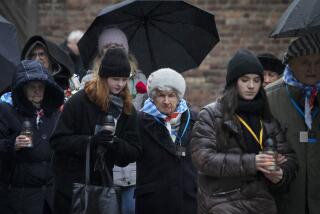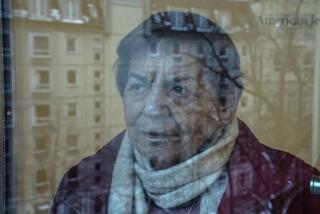Richard Ehrlich photographs an archive of Holocaust cruelty
FOURTEEN months ago, Richard Ehrlich left his office at the UCLA Medical Center, flew to Berlin and rented the best digital camera available. With the 39-megapixel Hasselblad safely stowed, he drove about 250 miles to the small town of Bad Arolsen and found his way to the International Tracing Service.
Ehrlich, a veteran urological surgeon with a second career in photography, had pulled plenty of strings to take pictures in the sprawling, six-building complex. But what he found was beyond comprehension: 50 million documents of Nazi atrocities in the world’s largest Holocaust archive.
The vast repository would become the subject of hundreds of photographs, shot over seven intensely focused days and winnowed to a 54-image portfolio. He started in June 2007 and returned in September, taking long views of the storage system and close-ups of individual items, including Oskar Schindler’s list of people who escaped death by working in his factory, a pile of snapshots confiscated from prisoners, badges that Jews were forced to wear, the order that sent Anne Frank to Bergen Belsen, where she died in 1945.
If the records and artifacts were placed side by side, Ehrlich says, they would form a 16-mile path into the minds and practices of Adolf Hitler’s followers, who attempted to eradicate Jews and others deemed defective or undesirable. The materials -- divided into sections on incarceration, forced labor and migration -- are stored on shelves and in cabinets, arranged in neat rows in a former military facility.
Orderliness -- “the banality of evil,” as Ehrlich calls it, quoting author Hannah Arendt -- is part of the story.
The archive contains the names of 17.5 million people who were murdered or persecuted by the Nazis in World War II. Three-hundred and fifty boxes of files pertain to 250,000 children separated from their parents. Thousands of ring binders document what went on in ghettos, prisons and concentration camps, including exterminations and medical experiments.
One ledger lists 48 prisoners who were lined up and executed, one person every two minutes, to celebrate Hitler’s birthday in 1942. Another records the number of lice found on individual prisoners during inspections intended to prevent typhus.
“You are immediately struck by the enormity of this and the meticulousness of the records,” Ehrlich says. “That’s the astounding part, that they kept these records. I guess that is part of their gestalt.”
His visual account of the experience includes straight documentary images that get right to the point. But it also contains evocative near-abstractions that find an eerie beauty in stacks of paper, edges of notebooks and illuminated corridors.
The first exhibition of the portfolio will be held at the Craig Krull Gallery in Bergamot Station, in Santa Monica, Tuesday through Saturday. Sponsored by the Consulate General of the Federal Republic of Germany in Los Angeles and the American Jewish Committee’s Los Angeles chapter, the show will fill the entire gallery.
Additional exhibitions are being planned at the Santa Barbara Museum of Art; the University at Buffalo Art Gallery, State University of New York; the Herbert F. Johnson Museum of Art at Cornell University in Ithaca, N.Y.; and the Museum of Judaism in Paris. The portfolio will be published in book form by Éditions de la Martinière in France. Ehrlich has not sold any of the pictures, but he and his supporters have donated portfolios to universities and Jewish institutions.
A native of New York City who was educated at Cornell University and Medical College, Ehrlich has lived in Los Angeles since 1971 and still maintains an active medical practice. His passion for photography began in his childhood, but he left it behind and only picked it up again seven years ago.
“It has taken over my life,” says Ehrlich, who credits his reawakening to an invitation to Staples Center. The hockey game bored him, but a display of photographs grabbed his attention.
“I thought it was something I should get re-involved in,” he says. “I started reading and talking and taking pictures and making a lot of mistakes. It was a leap of faith because everything had changed. Today, everything is digital.”
As he got up to speed, he shot landscapes, architecture, sunsets and graffiti -- whatever caught his eye as he roamed the world. In one series, published in a 2007 book, he photographed sand-filled houses in an abandoned mining town in Namibia. His work has been exhibited in galleries across the country and has landed in collections of several museums including the Los Angeles County Museum of Art and the Denver Art Museum.
The Holocaust project began a few years ago, when Ehrlich spotted an article about the Bad Arolsen archive in the International Herald Tribune. “About two years ago, I tried to gain access to it and could not,” he says. “Then I found out that the victims, not many of whom are left, and their families were having the same problem.”
Created by the International Committee of the Red Cross after World War II to help track down missing people and reunite families and funded by the German government, the International Tracing Service is supervised by an international commission, composed of representatives from 11 countries. “For reasons that are not well understood, they kept this under wraps for a long time. That’s not to say some people did not get in, but very few.”
When criticism of ITS policies and practices had been aired previously, defenders of the agency had contended that putting the archive in usable order would be an enormous task and that privacy issues would make public access complicated.
Refusing to accept defeat, Ehrlich made lots of calls and eventually reached a U.S. State Department official who made the necessary connection. He was on his way, but not without trepidation. “Not only was I unsure about how I would be received, I didn’t know if this would be a good photographic opportunity,” he says. “And then, when you go to the place, it’s overwhelming.”
His timing was fortuitous. After much delay, the ITS had begun digitizing the archive to preserve the documents and make them available online at other Holocaust centers -- including Yad Vashem in Jerusalem, the U.S. Holocaust Memorial Museum in Washington, D.C., and Poland’s Institute of National Remembrance, based in Warsaw. Although the project will take years to complete, staff members familiar with the material offered guidance to the California photographer.
“The people there were very nice to me,” Ehrlich says, “and yet this is a job for them. They come to work at 8 a.m. and leave at 5 p.m.”
“The hardest part was that I wanted the images to be photographically exciting, but the subject is so nasty,” he says. “How do you make something artistic when it’s so emotional and horrible? I just had to do the best I could.”
More to Read
The biggest entertainment stories
Get our big stories about Hollywood, film, television, music, arts, culture and more right in your inbox as soon as they publish.
You may occasionally receive promotional content from the Los Angeles Times.






